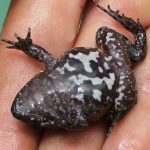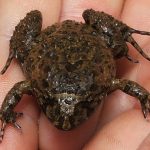TUSKED FROG
The Tusked Frog: a small brawler of the rainforest
Step into a warm, moonlit evening on Australia’s east coast. The air smells of damp earth and crushed leaves. Along the edge of a shaded creek, the water moves slowly, threading past ferns and paperbarks. From the leaf litter comes a low, repetitive grunt—soft and steady—like a tiny motorbike revving somewhere out of sight. You wait, eyes adjusting, until a compact frog eases into view. Its skin is dark olive-brown, mottled with irregular blotches that melt into the shadows. When a rival drifts too close, the male turns his broad head, revealing the secret of his name: two tiny, sharpened “tusks” along his lower jaw.
This is the Tusked Frog, small in size, but brimming with character.
Quick ID: what to look and listen for
- Build and colour: Robust body; dark olive to brown with darker blotches for excellent camouflage among wet leaves and muddy edges.
- The “tusks”: Males have small, pointed jaw projections—actually elongated teeth—used in territorial combat with other males.
- Size: Males are smaller (around 30–45 mm); females are larger (often 50–70 mm).
- Belly: Often marbled black-and-white beneath—striking if you get a careful, respectful view.
- Call: A low, repetitive grunt, often compared to a distant motorbike idling. Most active during spring and summer nights.
Where they live
- Range: Native to eastern Australia, especially coastal and near-coastal regions of Queensland and north-eastern New South Wales.
- Habitats: Slow-moving freshwater—creeks, ponds, marshy soaks, and flooded leaf litter. They favour places with dense vegetation, shaded banks, and calm water.
Imagine your torch beam sliding over still water: floating leaves, the glint of an insect’s wing, and the soft rattle of frogs calling from the margins. That’s Tusked Frog country.
Diet and ecological role
- What they eat: Mostly invertebrates—insects, worms, spiders, and other small creatures.
- Why it matters: By consuming a wide range of invertebrates, Tusked Frogs help keep local pest populations in balance, supporting healthier wetlands and gardens.
Breeding and family life
- Season: Warmer months—typically spring through summer, especially after rain.
- Courtship: Males produce a series of soft, grunting calls to draw females in close.
- Eggs: Females lay eggs in shallow, still water—often within or beside a foam nest at the water’s edge.
- A rare guardian: Unusually for frogs, the male Tusked Frog often stays near the eggs and guards them until hatching—fending off intruders with his tusks and broad head.
- Tadpoles: Tadpoles are well adapted to quiet, vegetated waters and develop over weeks to months, depending on temperature and food.
This quiet parental watchfulness is easy to miss, but it’s one of the most endearing scenes in the wet night world: a small sentinel ensuring the next generation slips safely into the water.
Lifespan and challenges
- Lifespan: Several years, though precise figures in the wild are not well documented. Survival depends on habitat quality, available food, and avoiding predators such as birds, fish, and snakes.
- Threats:
- Loss and fragmentation of freshwater habitats
- Pollution and sediment runoff
- The chytrid fungus,
Batrachochytrium dendrobatidis, which has harmed frog populations across the globe
Listen for the call
- Sound: Low, repetitive grunts—regular and subdued.
- When to listen: Warm, humid evenings in spring and summer, especially after rainfall.
- Where: Quiet creek lines, ponds with good vegetation cover, and the leafy edges of rainforest or wet sclerophyll forest.
Close your eyes and the soundscape sharpens: water whispering over pebbles, crickets fizzing in the undergrowth, and that gentle “motorbike” murmur pulsing from the shadows.
How you can help
- Protect and restore vegetation along creeks and farm dams—shade keeps water cooler and cleaner.
- Keep leaf litter, logs, and native plants around garden ponds for shelter.
- Avoid introducing fish to frog habitat; many fish eat eggs and tadpoles.
- Reduce pesticide and fertiliser use; prevent wash-off into drains and waterways.
- Clean and dry boots, nets, and gear between sites to help limit the spread of chytrid fungus.
- Record frog calls with community science programs (such as FrogID in Australia) to support conservation research.
Fast facts at a glance
| Feature | Detail |
|---|---|
| Scientific name | Adelotus brevis |
| Family | Limnodynastidae |
| Size | Males ~30–45 mm; females often 50–70 mm |
| Colour | Dark olive to brown with irregular darker blotches |
| Call | Low, repetitive grunts (motorbike-like) |
| Breeding season | Spring–summer, especially after rain |
| Notable behaviour | Males guard eggs—uncommon among frogs |
A final thought
The Tusked Frog is a quiet reminder that even small creatures can hold entire ecosystems together—one mouthful of insects, one guarded clutch of eggs, one evening chorus at a time. When we keep our waterways shaded, clean, and connected, we not only protect a single frog; we safeguard the living tapestry that surrounds it.


